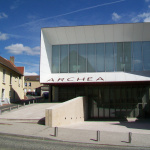From October 4 to 14, 2024, the Fête de la Science returns with an abundance of programming around the theme of "Oceans of Knowledge" in Paris and throughout the Île-de-France region. Numerous events are being organized for this 32nd edition, in the departments of Ile-de-France, particularly in Val-d'Oise, for all ages. Enough to inspire the youngest and create budding scientists in the future!
This incredible cultural event offers free educational workshops, conferences, escape games and other activities based on the vast universe of science, from climate and biodiversity to space. The whole family can take part, and meet scientists who will be exhibiting their advances and exceptional research at universities and museums across the département.
And for those brave enough to travel a little further afield, we don't hesitate to take a look at events in neighbouring départements, or even in Paris itself, with even more events on the programme!
Fête de la Science 2024: Paris program by arrondissement
For this Fête de la Science 2024, Paris invites curious people of all ages to meet scientists and take part in free events and workshops, across the city's various museums and institutions, from October 4 to 14, 2024. Discover the program by arrondissement in the capital! [Read more]
Fête de la Science 2024 in Paris and Ile-de-France, free events to discover
The Fête des Sciences returns from October 4 to 14, 2024 for its 33rd edition! What's it all about? A week dedicated to scientific culture, with numerous free events all over France. Experiments, shows, open houses, visits and a host of workshops, open to all and adapted to children, await you in the four corners of Paris and the Île-de-France region! [Read more]



 Fête de la Science 2024: discover the Gallo-Roman sanctuary of Les Vaux de la Celle (95)
Fête de la Science 2024: discover the Gallo-Roman sanctuary of Les Vaux de la Celle (95)
During the Fête de la Science 2024, from October 4 to 14, 2024, many Parisian and Ile-de-France venues and institutions are opening their doors with workshops around the theme of this 33rd edition, Oceans of Knowledge. [Read more]



 Fête de la Science 2024: events, workshops and activities in Cergy-Pontoise (95)
Fête de la Science 2024: events, workshops and activities in Cergy-Pontoise (95)
From October 4 to 14, 2024, the Cergy-Pontoise conurbation invites you to discover its scientific institutions during the 33rd Fête de la Science. [Read more]



 Fête de la Science 2024: discover Archéa, archaeology museum in the Pays de France
Fête de la Science 2024: discover Archéa, archaeology museum in the Pays de France
From October 4 to 14, 2024, the Fête de la Science is celebrated in Paris and throughout the Île-de-France region, with a host of exceptional events on the program. At Archéa, the museum of archaeology in the Pays de France region, you can take advantage of exclusive events. [Read more]
In Bray-et-Lu
In Cergy
In Genainville
In Guiry-en-Vexin
In Louvres
In Magny-en-Vexin
In Marines
In Nucourt
In Saint-Ouen l'Aumône
In Villiers-le-Bel
Dates and Opening Time
From October 4, 2024 to October 14, 2024
Prices
Free
Official website
www.fetedelascience.fr



 Fête de la Science 2024: Paris program by arrondissement
Fête de la Science 2024: Paris program by arrondissement


 Fête de la Science 2024 in Paris and Ile-de-France, free events to discover
Fête de la Science 2024 in Paris and Ile-de-France, free events to discover














